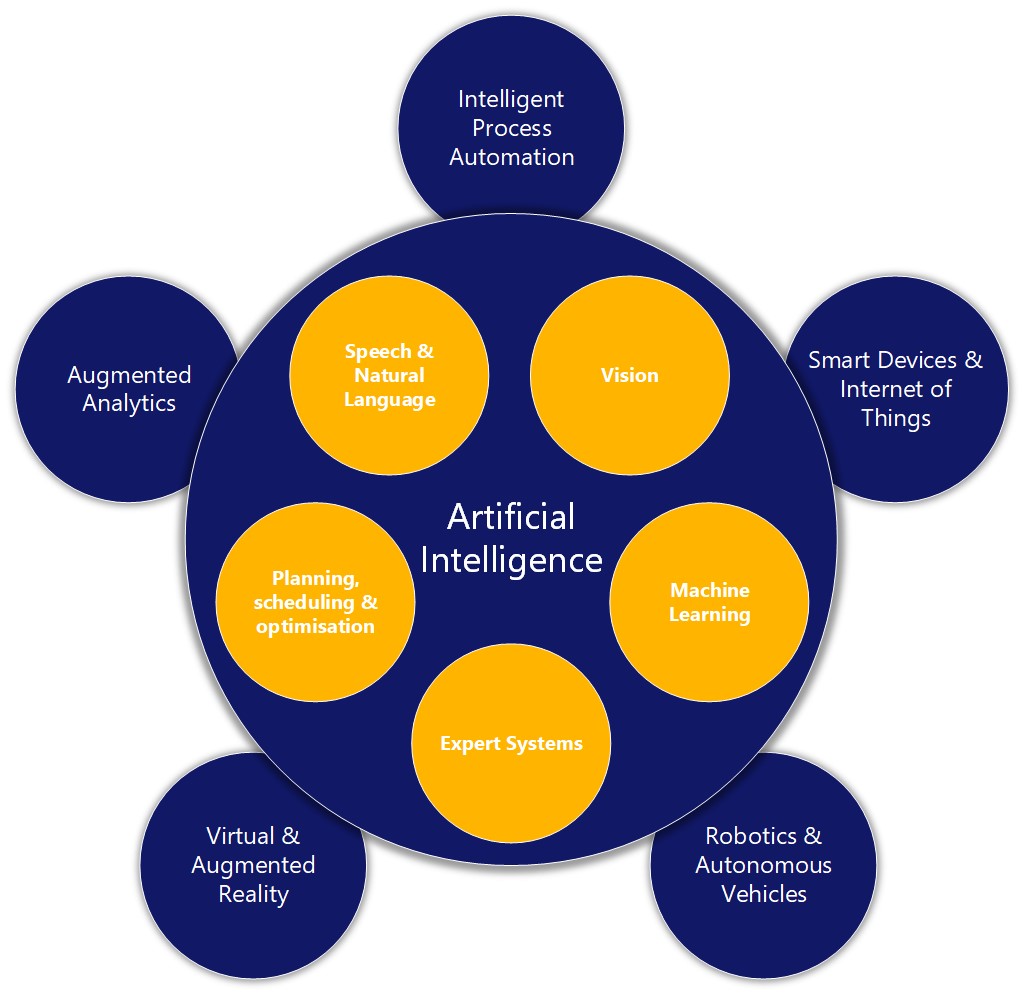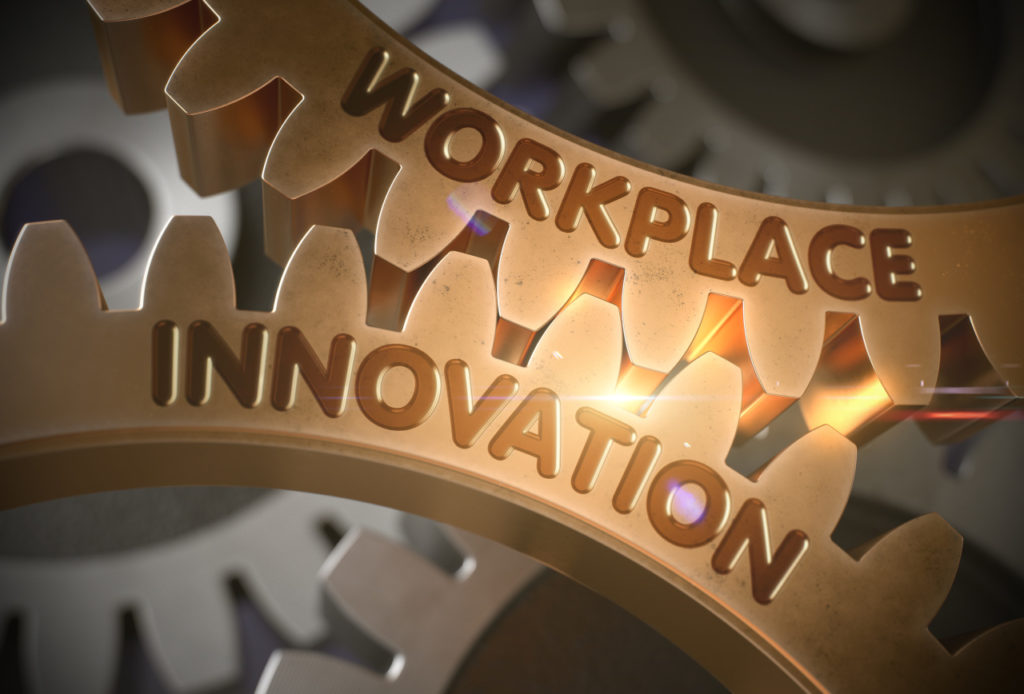Introduction – 5 for Friday
Welcome to our first ‘five for Friday’ blog! A series of articles we’re going to post on a Friday, although perhaps not every Friday! Each will present 5 interesting insights into a chosen topic. We’ll cover intelligent technologies, their application and the opportunities and challenges they present. Please subscribe to our newsletter in the footer below to receive these articles automatically into your inbox. Alternatively follow us on LinkedIn via our company page, Combined Intelligence, to receive via LinkedIn notifications.
If you have any feedback or want us to cover a particular topic please email us at info@combined-intelligence.co.uk.
Intelligent technologies will transform the workplace
Artificial Intelligence and related intelligent technologies (see illustration below), such as intelligent process automation, smart devices and augmented analytics, are and will transform how we work. The rise of the digital workforce enabled by these technologies will also radically change many of our roles within organisations. What we do and how we do it, for progressive and successful organisations, will be significantly different in 10 years time to what we do now.
Below we present 5 of the key ways we believe this will happen over the coming years. We recommend that organisations should include these in their vision, strategy and roadmap. The future workplace is arriving fast!

Figure 1: Intelligent Technologies
The Five
We present our five below with a focus on the positive benefits of these technologies and workplace transformations. We’ll pick up on the challenges and potential downsides in future 5 for Friday posts.
1. Digital Workforce and Automation
Process automation via robotic process automation and low/no-code approaches is already removing the need for people to perform mundane and repetitive tasks. Activities to take data from one system and put it into another can now be done more accurately, reliably and faster by technology rather than people. Business rules can be encapsulated in workflow to replicate decisions and to enable multi-stage processes to be performed automatically.
Intelligent process automation (IPA), adding AI to process automation, is enabling the processing of unstructured data including documents. Machine learning is allowing processes to learn how to make complex decisions that go well beyond basic rules.
Hyperautomation, IPA at scale, will increasingly delivering a digital workforce that runs alongside the human workforce. Enabling the human workforce to focus on interacting with customers and colleagues rather than business systems, spending their time innovating and on higher value work.
Advances in automation tools are democratising automation, enabling everyone to build automations rather than just a select specialist few.
The future will see a much greater acceptance that an organisation’s workers will consist of both a Digital Workforce and a Digitally enabled Human Workforce that will need to work together to be truly productive and successful.
2. Customer Engagement
The last 10 years has seen a big push to transition customer engagement to digital channels. Digital Transformation programmes have targeted moving customers from face to face and phone interactions to online. This channel shift has enabled new ways to interact and reduced the cost to engage with customers. The pandemic has also accelerated this due to remote working and impacts on the availability of the human workforce.
Smart devices, powered by Alexa, Siri, Google and others, are beginning to enable us to understand the potential to interact with technology by voice. Further advances in Conversational AI will enable us to interact (speech, chat, gestures and video) with technology in increasingly detailed and interactive ways. Enabling us to hold conversations with technology that can answer our (customer) questions and allow us to transact in a similar (or even improved) way to how we traditionally would have done over the phone or even face to face. Omni-channel implementations will enable us to seamlessly transition across channels and devices. Picking up from where we left off even when transitioning the engagement from technology to a real person.
A better understanding of our customers and potential customers (see insight) will enable us to anticipate customer needs and proactively engage.
New virtual technologies (see virtual workplaces) will provide new ways to remotely achieve a more face to face like experience.
Customer services teams will be able to focus on building customer rapport, handling more complex customer needs, upselling and ultimately raising customer satisfaction. Using time freed up by technology.
3. Data and Insight
Organisations already gather a lot of data and this will continue to increase. The internet of things (IoT) will add massive amounts of further data as these connected devices increasingly monitor the environment, buildings, vehicles and even people. Other technologies, such as blockchain, will improve traceability, reliability and security of information.
Improvements in how data is stored, linked and securely made available (e.g. via the cloud/edge) will improve data access. Opportunities to share data, hopefully with good ethical and privacy governance, will enhance the completeness of this underlying data increasing the potential to get value from it.
Augmented analytics, extending analytics with AI, will enable greater insight into customers, organisations, the environment and more. These technologies will not just provide traditional insights based on what people ask but will be able to identify new insights by finding hidden patterns in volumes of data that people and traditional analytics can’t.
Dedicated cloud and edge based AI processing capabilities will enabled data to be analysed and processed in real time. Enabling insight to be provided and used in real-time. Automation and machine learning will be able to use data to learn and make increasingly intelligent decisions, also being able to dynamic adapt and self-optimise.
4. Virtual Workplaces and Extended Reality
The pandemic has accelerated the adoption of digital collaboration technologies such as Microsoft Teams, Zoom, Slack and others. The new normal is expected to include an acceptance that remote working will continue as we likely return only part time to the office. This distributed workforce will further drive the evolution of technologies such as extended reality (including virtual and augmented reality) enabling us to meet and interact in virtual environments.
These virtual workplaces will enable us to collaborate with people across the world. They will also enable us to simulate not just a virtual face to face meeting experience but further to a complete office/work and even social environment. This will go much of the way towards enabling remote workers to gain many of the traditional benefits of an office environment, reducing the feeling of being disconnected but still retaining the benefits of remote/home working.
These virtual workplaces will also enable an extended experience, providing new virtual ways to access data, run simulations, utilise digital twins, virtual assistants (below) and much more.
Augmented reality will also enable us to enhance our experience of the real world. Providing ready access to information that overlays and augments what we see and hear. Helping us to work more efficiently and safely.
5. Virtual Assistants
Smart devices are enabling us to interact with technology to perform simple actions. Automation is providing the ability to action more complex activities. The growth in data, increased connectivity and other applications of intelligent technologies are increasing our access to knowledge and insight. Virtual reality and augmented reality are providing new ways to enhance our physical and virtual world.
The combination of these technologies will enable us to have virtual assistants (think J.A.R.V.I.S in the Iron Man/Marvel movies). We’ll be able to communicate with these assistants naturally, asking them to do things for us, from booking meetings, through automated minute/action taking and on to more complex activities such as preparing a presentation or onboarding a new client. Learning and personalisation will enable the assistant to do things the way we, as individuals, want them to and even to adopt a preferred personality (voice, appearance and behaviour).
Our virtual assistants will be able to connect/reside in increasingly intelligent devices. Allowing our assistants to do things physically for us, from getting us a coffee through to driving us to the office.
The future workplace is coming soon. It’s important that organisations recognise this and create a strategy to not only embrace the adoption of these new technologies but also to ensure a positive evolution in the role of the human workforce. If you want to know more then please get in touch (info@combined-intelligence.co.uk). We can help you from vision through to realisation.
Please also subscribe below to our newsletter so that you can receive future 5 for Friday posts as well as other interesting news, blogs and articles direct to your inbox. You can also follow us on LinkedIn.

